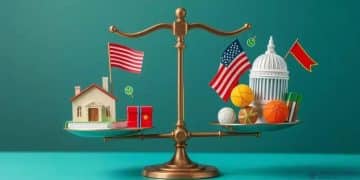New developments in student loan forgiveness initiatives

New developments in student loan forgiveness initiatives are expanding access, simplifying eligibility, and enhancing support for borrowers, significantly impacting their financial futures and the overall economy.
New developments in student loan forgiveness initiatives are making headlines, and it’s crucial to stay informed. These changes could significantly alter your financial landscape. Are you aware of the latest options available for easing your student debt burden?
Understanding student loan forgiveness programs
Understanding student loan forgiveness programs is essential for anyone with student debt. These programs are designed to help borrowers reduce or eliminate their financial burdens. With the rising costs of education, knowing how these initiatives work can greatly benefit students and graduates alike.
What Are Student Loan Forgiveness Programs?
Student loan forgiveness programs provide relief to borrowers under specific conditions. They allow you to have a portion or all of your loans cancelled, helping to alleviate financial stress.
Types of Forgiveness Programs
There are several types of student loan forgiveness programs available:
- Public Service Loan Forgiveness: Designed for those who work in public service jobs.
- Teacher Loan Forgiveness: Available for qualified teachers in low-income schools.
- Income-Driven Repayment Forgiveness: Your loans can be forgiven after a set number of payments based on your income.
- Federal Perkins Loan Cancellation: For borrowers who work in certain fields such as law enforcement or teaching.
Eligibility criteria vary for each program, making it crucial to understand your options. For example, Public Service Loan Forgiveness requires 120 qualifying monthly payments, while Teacher Loan Forgiveness may reduce your total loans if you teach for five consecutive years.
Many borrowers often overlook these programs, missing out on potential savings. Knowing how to apply correctly can make a significant difference in your financial journey.
Understanding the details, such as eligibility requirements and application processes, is the first step towards reducing your debt. Take the time to research what programs suit your situation best. Staying informed about the latest updates in these initiatives will help you stay ahead.
Recent changes to forgiveness policies

Recent changes to forgiveness policies have been significant for borrowers across the nation. These updates reflect a growing response to the financial challenges many graduates face. Understanding these changes can help you navigate your student debt better.
Overview of Changes
Recently, several policies have been altered to provide greater relief to borrowers. For instance, the Public Service Loan Forgiveness program has seen reforms aimed at simplifying the application process. Now, borrowers are having an easier time obtaining forgiveness after years of qualifying payments.
Key Changes Implemented
Some important adjustments to forgiveness policies include:
- Expanded eligibility: More types of jobs now qualify for loan forgiveness, including more public sector positions.
- Streamlined application procedures: Reducing paperwork and making it easier to submit requests for forgiveness.
- Temporary relief measures: Initiatives like the pause on student loan payments have given borrowers breathing room to apply for forgiveness.
- Community service recognition: Volunteering hours can now count towards forgiveness qualifications.
These policy changes are essential because they aim to lighten the burden on those struggling with student loans. Furthermore, the temporary measures introduced during the pandemic have set a precedent for ongoing support. As borrowing costs rise, staying aware of the policies that directly impact you is important.
The landscape of student loan forgiveness is evolving, and understanding these recent changes will empower you to take action. As more changes emerge, keeping updated will be crucial for your financial health.
How to apply for loan forgiveness
Applying for loan forgiveness can be a straightforward process if you follow the right steps. Knowing how to navigate this process is crucial for securing financial relief from your student loans. Let’s break down the steps involved to make the application easier for you.
Steps to Apply for Loan Forgiveness
The application process may vary depending on the type of forgiveness program you are applying for. Here are some common steps to keep in mind:
- Determine Eligibility: Verify that you qualify for the specific forgiveness program. Each program has its own set of requirements.
- Gather Documentation: Collect necessary documents such as proof of employment, payment history, and any forms specific to the forgiveness program.
- Complete the Application: Fill out the required forms accurately. Make sure to double-check for any errors before submission.
- Submit the Application: Send your application and any supporting documents to the appropriate loan servicer or agency.
It’s important to submit your application well before any deadlines. Some programs require you to submit applications annually, while others may have one-time application processes. Be proactive about keeping track of your submission status.
After you’ve submitted your application, be prepared for a waiting period. Loan servicers may take time to process applications and verify all information. During this waiting period, maintain regular communication with your loan servicer.
Paying attention to details throughout the application will increase your chances of approval. For instance, if you are applying for Public Service Loan Forgiveness, ensure that all your eligible payments are accounted for and that your employer qualifies under the program’s guidelines.
Impact of forgiveness on borrowers and the economy

The impact of forgiveness on borrowers and the economy is significant and far-reaching. Understanding these effects helps highlight why these policies are crucial for many individuals and for society as a whole.
Effects on Borrowers
When borrowers receive forgiveness, they often experience immediate financial relief. This relief can lead to several positive outcomes:
- Increased disposable income: With less debt, individuals have more money to spend on essential needs.
- Better credit scores: Paying off loans can improve credit ratings, allowing access to credit with better terms.
- Enhanced mental well-being: Reducing financial stress can lead to improved mental health and life satisfaction.
Many borrowers report feelings of freedom after receiving forgiveness. This emotional relief can encourage them to invest in their futures, such as buying a home or starting a business.
Impact on the Economy
The broader economic implications of loan forgiveness are equally important. When borrowers are relieved of their debt, they contribute to the economy in greater ways:
- Stimulating economic growth: Increased consumer spending can stimulate local businesses.
- Job creation: As individuals invest in their education and businesses, job opportunities may increase.
- Reducing wealth inequality: Forgiveness helps level the financial playing field, particularly for low-income borrowers.
Moreover, relieved borrowers may also be more likely to engage in further education, enhancing their skills and employability. This investment in human capital benefits the workforce and the economy.
Recognizing the impact of forgiveness is essential as it underscores the importance of continued support for such programs. As the economy continues to evolve, these policies can provide crucial pathways for growth and recovery.
Future trends in student loan forgiveness
Future trends in student loan forgiveness are shaping how borrowers will address their financial obligations. As education costs rise and economic factors shift, these trends indicate significant changes ahead.
Increased Access to Forgiveness
In the coming years, we may see an expansion of loan forgiveness programs. More borrowers could qualify, particularly in sectors that are critical to community welfare, such as education and healthcare. Efforts to bridge gaps in these vital areas may result in increased resources allocated for forgiveness initiatives.
Policy Reforms and Legislative Changes
Anticipated legislative changes could simplify the application process. Policymakers are actively discussing reforms that aim to make applying for loans and forgiveness easier. This shift could include streamlined processes and reduced paperwork, enabling borrowers to navigate their options more efficiently.
- Wider Scope of Eligibility: More professions may become eligible for forgiveness, addressing shortages in various fields.
- Improved Communication: Enhanced outreach and education on available programs could help borrowers understand their rights and options.
- Forgiveness for Unique Circumstances: Expect policies to adapt to modern challenges, possibly providing forgiveness for unique life situations like caregiving or natural disasters.
Technology will also play a role, with online platforms offering intuitive ways to track eligibility and payments. As more data becomes available, lenders may provide personalized forgiveness solutions.
As discussions about student debt continue, public awareness will likely rise, leading to advocacy for more forgiving policies. This social movement may push for a system that prioritizes education over debt.
Staying informed about these trends is crucial for borrowers, as they signify a shift toward a more supportive financial landscape for students and graduates.
FAQ – Frequently Asked Questions about Student Loan Forgiveness
What are the eligibility requirements for student loan forgiveness?
Eligibility varies by program, but generally requires steady repayments and working in qualifying jobs, like public service or education.
How long does it take to receive loan forgiveness?
The time varies depending on the program and individual circumstances, but it can take several months after application submission.
Can I apply for forgiveness if I have multiple loans?
Yes, you can apply for forgiveness for different loans, but each program has its own rules and requirements.
What should I do if my forgiveness application is denied?
If denied, review the reasons provided, consider appealing the decision, and ensure all documentation was submitted correctly.





